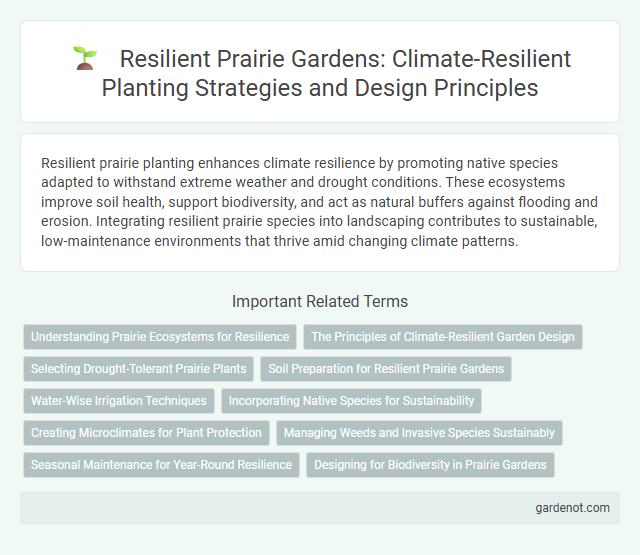Resilient prairie planting enhances climate resilience by promoting native species adapted to withstand extreme weather and drought conditions. These ecosystems improve soil health, support biodiversity, and act as natural buffers against flooding and erosion. Integrating resilient prairie species into landscaping contributes to sustainable, low-maintenance environments that thrive amid changing climate patterns.
Understanding Prairie Ecosystems for Resilience
Prairie ecosystems exhibit complex biodiversity that enhances climate resilience through deep-rooted grasses and diverse plant species, which improve soil stability and water retention. Understanding species interactions and native plant adaptations allows for strategic planting that mitigates drought and erosion impacts. Leveraging native prairie flora supports ecosystem services critical to maintaining long-term agricultural productivity and biodiversity under changing climate conditions.
The Principles of Climate-Resilient Garden Design
Resilient prairie gardens utilize native grasses and wildflowers adapted to withstand extreme weather fluctuations and drought conditions, enhancing biodiversity and soil health. Key principles include selecting plant species with deep root systems to improve water retention and carbon sequestration, alongside spatial diversity to mitigate pest outbreaks and improve microclimates. Incorporating seasonal variation in plant phenology supports pollinators year-round, reinforcing overall ecosystem resilience to climate change.
Selecting Drought-Tolerant Prairie Plants
Drought-tolerant prairie plants such as little bluestem (Schizachyrium scoparium) and purple coneflower (Echinacea purpurea) are essential for climate-resilient planting due to their deep root systems and ability to thrive in low-water conditions. These species improve soil structure, enhance carbon sequestration, and support pollinators during extended dry periods. Selecting native prairie grasses and wildflowers adapted to local climate zones ensures sustainability and maximizes ecological benefits in drought-prone landscapes.
Soil Preparation for Resilient Prairie Gardens
Effective soil preparation is crucial for resilient prairie gardens, ensuring optimal root growth and water retention. Incorporating organic matter and minimizing soil disturbance enhance microbial activity and nutrient availability, fostering a robust plant community. Proper soil aeration and pH balancing further strengthen plant resilience against drought and extreme weather conditions.
Water-Wise Irrigation Techniques
Resilient prairies thrive with water-wise irrigation techniques that conserve moisture and support native plant growth by mimicking natural rainfall patterns. Drip irrigation systems minimize water use by delivering precise amounts directly to root zones, reducing evaporation and runoff. Integrating soil moisture sensors ensures irrigation occurs only when necessary, enhancing drought resilience and promoting sustainable prairie ecosystems.
Incorporating Native Species for Sustainability
Incorporating native species in resilient prairie restoration enhances biodiversity and ecosystem stability by supporting local wildlife and soil health. Native grasses like big bluestem and switchgrass exhibit deep root systems that improve water retention and reduce erosion, essential for climate resilience. This sustainable approach promotes long-term adaptability to extreme weather conditions while maintaining ecological balance.
Creating Microclimates for Plant Protection
Resilient prairie ecosystems enhance plant survival by creating microclimates that moderate temperature extremes and retain soil moisture. Native prairie grasses and forbs establish windbreaks and shade, reducing heat stress and preventing erosion. These microclimates support biodiversity and improve overall climate resilience in planting projects.
Managing Weeds and Invasive Species Sustainably
Resilient prairie ecosystems maintain biodiversity by employing sustainable weed and invasive species management techniques such as prescribed burning, targeted grazing, and selective herbicide application. These methods enhance native plant competition, prevent the establishment of aggressive non-native species, and promote soil health and water retention. Monitoring invasive species populations and integrating adaptive management strategies ensures long-term prairie resilience against climate change impacts.
Seasonal Maintenance for Year-Round Resilience
Seasonal maintenance of resilient prairies involves strategic practices such as controlled burning, targeted mowing, and timely invasive species removal to support native plant health and soil vitality. These techniques enhance biodiversity, promote deep root systems, and improve water retention, ensuring robust growth during droughts and floods. Regular monitoring and adaptive management sustain prairie ecosystem functions, bolstering climate resilience throughout the year.
Designing for Biodiversity in Prairie Gardens
Resilient prairie gardens incorporate diverse native plant species that enhance ecosystem stability and support pollinator populations, reducing vulnerability to climate stressors. Designing for biodiversity involves selecting deep-rooted grasses and wildflowers that improve soil health, retain moisture, and withstand extreme weather events. These practices increase habitat complexity, promoting wildlife resilience and ecosystem services essential for climate adaptation.
Resilient prairie Infographic

 gardenot.com
gardenot.com